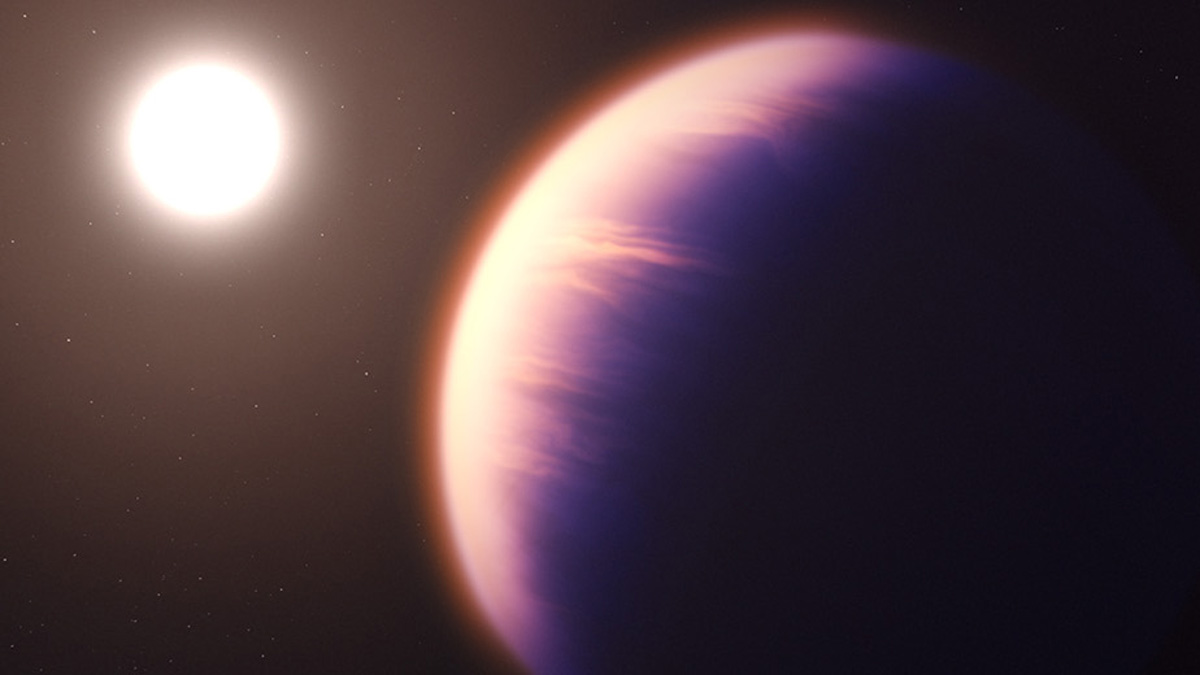James Webb Space Telescope sniffs out carbon dioxide around an alien world
No telescope has ever detected carbon dioxide in an exoplanet atmosphere before.

The James Webb Space Telescope (JWST or Webb) has detected carbon dioxide in the atmosphere of an exoplanet in a breakthrough discovery that will usher in a new era of research on worlds outside our solar system.
The detection came during the James Webb Space Telescope's first campaign focusing on exoplanets, which are planets orbiting other stars. The observations targeted a hot gas giant called WASP-39 b located some 700 light-years away from Earth in the constellation Virgo.
The planet, about as massive as Saturn but larger than Jupiter in size, had previously been observed by the Hubble Space Telescope in optical wavelengths and the now-retired Spitzer Space Telescope, which like Webb observed heat-carrying infrared wavelengths. The previous observations revealed the presence of water vapor, sodium and potassium in the planet's atmosphere, but it wasn't until Webb that scientists caught the signature of carbon dioxide.
"As soon as the data appeared on my screen, the whopping carbon dioxide feature grabbed me," Zafar Rustamkulov, a graduate student at Johns Hopkins University in Baltimore, USA and a member of the transiting exoplanet team which undertook this investigation, said in a statement. "It was a special moment, crossing an important threshold in exoplanet sciences."
Related: NASA's James Webb Space Telescope mission: Live updates
Carbon dioxide has never been detected on any exoplanet before. But astronomers hope that the compound can help them better understand the formation history and evolution of the planets where it's found, scientists said.
"This unequivocal detection of carbon dioxide is a major milestone for exoplanet atmosphere characterisation," Laura Kreidberg, director of the Max Planck Institute for Astronomy in Germany and co-author of a paper describing the discovery, said in a statement. "Carbon dioxide helps us measure the complete carbon and oxygen inventory of the atmosphere, which is highly sensitive to the conditions in the disk where the planet formed."
Get the Space.com Newsletter
Breaking space news, the latest updates on rocket launches, skywatching events and more!
Such measurements can help identify how far from its star the planet formed and determine how much solid and gaseous material it accumulated as it migrated to its current location.
The discovery was made using Webb's NIRSpec instrument, a highly sensitive spectrograph that splits incoming light into barcode-like spectra that reveal how the observed objects absorb light. Neither Webb nor any other existing telescope can capture direct images of the exoplanet or its atmosphere; instead, researchers compare observations of the star's typical light to light seen through the atmosphere as the planet passes in front of it.
The measurements of WASP-39 b were gathered on July 10, two days before the first official release of Webb images.
The researchers believe the telescope will be able to detect carbon dioxide in the atmospheres of other types of planets, including Earth-like rocky bodies scattered across the galaxy.
"The exoplanet community has been searching for the signature of carbon dioxide for decades," Kreidberg said. "With the extraordinary new capability of JWST, it will be possible to routinely detect carbon dioxide for hot Jupiters, as well as smaller, cooler planets more like our own Earth."
WASP-39 b orbits extremely close to its parent star, WASP-39, at less than 1/20th the distance between Earth and the sun), completing one orbit about every four Earth days. The planet was discovered in 2011 and can only be observed through the transits it makes around WASP-39, which cause brief dips in the star's brightness.
A paper describing the research has been accepted for publication by Nature; a preprint of the paper is available on arXiv.org.
Follow Tereza Pultarova on Twitter @TerezaPultarova. Follow us on Twitter @Spacedotcom and on Facebook.
Join our Space Forums to keep talking space on the latest missions, night sky and more! And if you have a news tip, correction or comment, let us know at: community@space.com.

Tereza is a London-based science and technology journalist, aspiring fiction writer and amateur gymnast. Originally from Prague, the Czech Republic, she spent the first seven years of her career working as a reporter, script-writer and presenter for various TV programmes of the Czech Public Service Television. She later took a career break to pursue further education and added a Master's in Science from the International Space University, France, to her Bachelor's in Journalism and Master's in Cultural Anthropology from Prague's Charles University. She worked as a reporter at the Engineering and Technology magazine, freelanced for a range of publications including Live Science, Space.com, Professional Engineering, Via Satellite and Space News and served as a maternity cover science editor at the European Space Agency.









